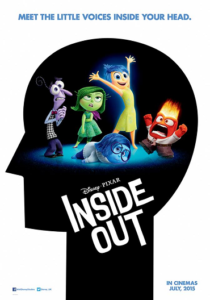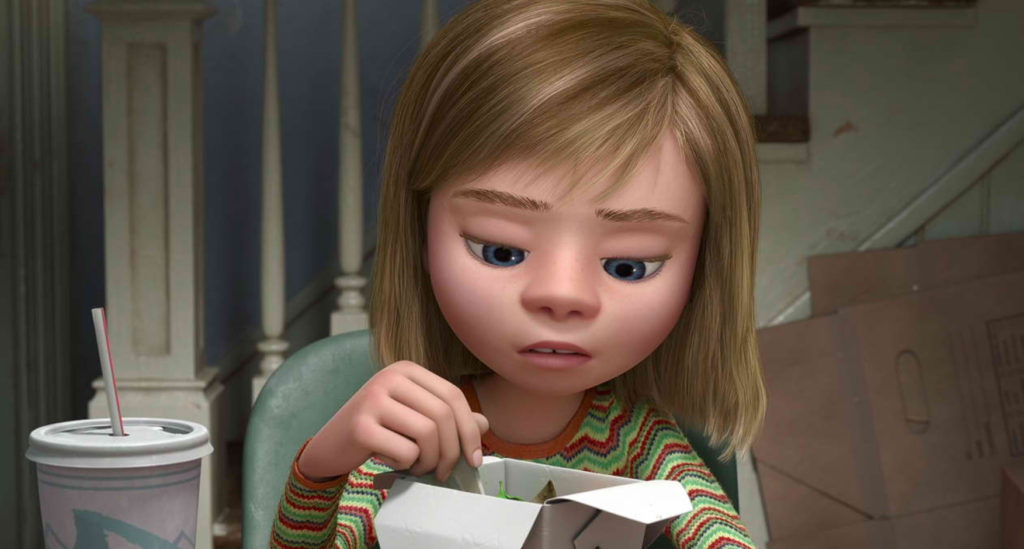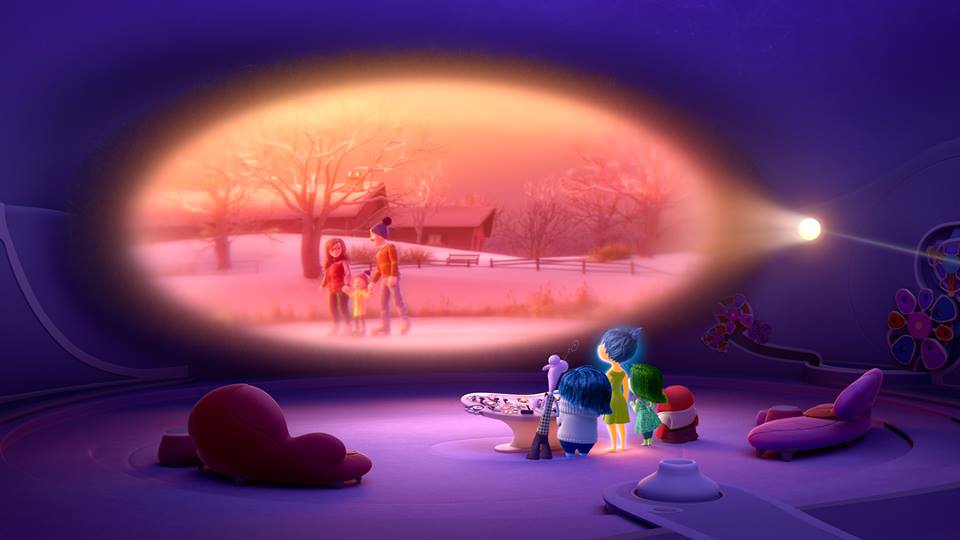Rethinking the Life of Riley
DIRECTED BY PETE DOCTOR/2015
 It is with great joy and a flurry of other emotions that I can report that Inside Out completely destroyed me. Which is more than okay; I mean that in the best way possible. It is the best work from Pixar in a while, and guaranteed to push many buttons in audience members of all ages.
It is with great joy and a flurry of other emotions that I can report that Inside Out completely destroyed me. Which is more than okay; I mean that in the best way possible. It is the best work from Pixar in a while, and guaranteed to push many buttons in audience members of all ages.
Just as the Toy Story films are actually about Andy (the boy who owns all the toys), Inside Out is about an eleven year old girl named Riley. Although the differences are numerous, the most obvious is that Inside Out doesn’t bother to be covert about the fact that it’s telling a story about navigating childhood, and growing up.
The film’s concept is far out yet completely accessible: The main characters are Riley’s emotions – Joy (Amy Pohler), Sadness (Phyllis Smith) Anger (Lewis Black), Disgust (Mindy Kaling) and Fear (Bill Hader). They are busy bees, working from their sleek “Headquarters” in a vast Tron-like landscape that is Riley’s mind. They manage her reactions, process her thoughts, and store her memories, the most important being the delicate and protected core memories – represented as large glowing marble-like orbs. At this phase of life, all five core memories are colored gold by Joy, who tasks herself with protecting these treasured, defining memories. For all of Riley’s life, joy has been the unquestioned top emotion, essentially acting as leader in the control room. But something is changing in the emotional dynamic in Headquarters. Sadness, who rarely had a foothold previously, is starting to rub off on everything. Things are turning blue all around. Riley will be twelve soon, and changes are happening fast.

Various passages on the adventure do get a bit (for lack of a better term) cerebral, but the whole inner world and playing-out of the film feels more as though the filmmakers didn’t spend a lot of time cramming on psychology texts as they simply observed their actual children, and then actualized their findings in high-end cartoon form. Characters ride the Thought Train, encounter Abstract Thought, and leap lava on couch cushion stepping stones.
Although this Pixar film is stocked with more comedians as voice talent than any other, (Pohler, Lewis Black, Bill Hader, Paula Poundstone, etc.) it is perhaps the least funny of the studio’s output. That’s not to say it’s unfunny, or copping the Paul Thomas Anderson model of casting comedians in serious roles, but it does point to that occasionally expressed truism that no performer understands the multi-faceted depths of human beings like funny people. Additionally, it’s great to hear some old guard Muppet performers showing up in this child’s mind. (Dave Goelz, Frank Oz). The air of the “paycheck gig”, so often lingering in the pulsing air of most animated studio fare, is not here. Everyone has heeded the Pixar call with honor, and give it their all.

©2014 Disney•Pixar. All Rights Reserved.
As for how kids will receive this, my nine year old son focused on the world building, although the melancholic takeaways did not altogether escape him. My seven year old daughter wept like I did through the entire movie (not just portions – the entire movie), so intuitive is she. My four year old son enjoyed it thoroughly as the colorful quest film it most certainly is.
I suppose this is the point in the review where I’m supposed to laud the film for so heavily and prominently forefronting female characters (and talent). But unlike, say, Disney’s recent Tomorrowland, in which the female lead character could’ve just as easily been rendered as male, and the story would not alter, Inside Out is different. This is a purely female experience film, (just as the coming of age aspects of Toy Story are recognizably male) even as it rings completely universal. If Inside Out was a male centric film, it would simply be a fundamentally different movie. There is no “forced progressive agenda” going on here, simply marvelous, human storytelling.

Towards the end of the end of the long credit roll, there’s a notice that reads, “Dediticated to our children – Don’t grown up. Ever.” As a parent, Inside Out is a wonderful, heartfelt, and at times raw reminder that your kids won’t be kids forever.
This is most certainly among the reasons the movie didn’t just make me cry once or twice – it made me tear up basically the whole time. But absolutely do not avoid seeing it. (Although its 3D version is a take-it-or-leave-it option.) It’s the rare movie that is wholly entertaining, brilliantly imaginative, universally resonant (even for those without children), and left this reviewer wanting to be a better parent. Inside Out is the best film of the year so far; its title an apt description of its positive emotional effect. In the core memories of the 2015 movie year, this one will continue to shine golden.


